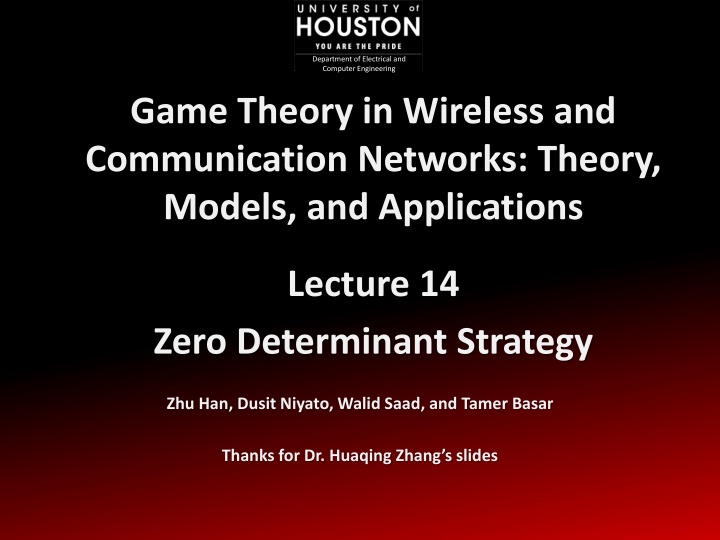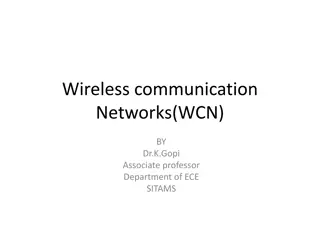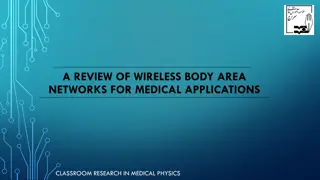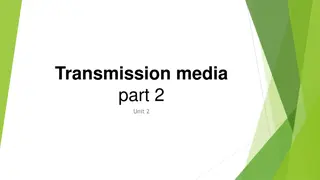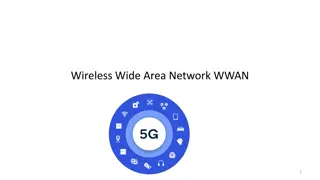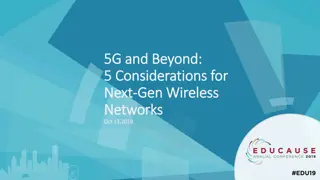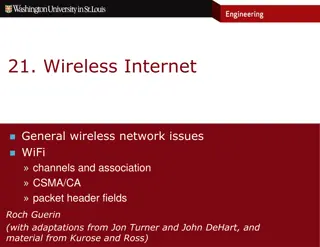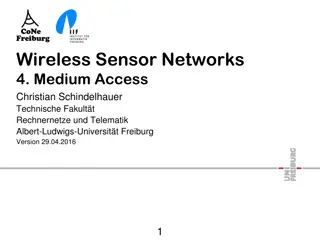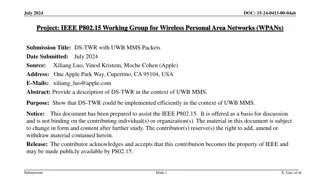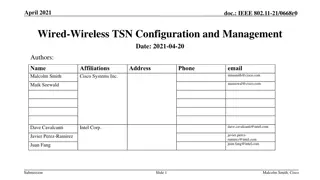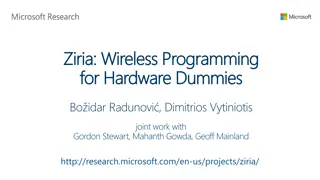Game Theory Applications in Wireless Communication Networks
Explore the application of game theory in wireless communication networks through lectures covering various game theory concepts such as non-cooperative games, Bayesian games, and cooperative games. The focus is on Zero-Determinant Strategy, a method used for resource sharing and power control in wireless cooperation scenarios. Examples include Cheating Management and Revenue Optimization in wireless network settings.
Download Presentation

Please find below an Image/Link to download the presentation.
The content on the website is provided AS IS for your information and personal use only. It may not be sold, licensed, or shared on other websites without obtaining consent from the author.If you encounter any issues during the download, it is possible that the publisher has removed the file from their server.
You are allowed to download the files provided on this website for personal or commercial use, subject to the condition that they are used lawfully. All files are the property of their respective owners.
The content on the website is provided AS IS for your information and personal use only. It may not be sold, licensed, or shared on other websites without obtaining consent from the author.
E N D
Presentation Transcript
Department of Electrical and Computer Engineering Game Theory in Wireless and Communication Networks: Theory, Models, and Applications Lecture 14 Zero Determinant Strategy Zhu Han, Dusit Niyato, Walid Saad, and Tamer Basar Thanks for Dr. Huaqing Zhang s slides
Overview of Lecture Notes Introduction to Game Theory: Lecture 1, book 1 Non-cooperative Games: Lecture 1, Chapter 3, book 1 Bayesian Games: Lecture 2, Chapter 4, book 1 Differential Games: Lecture 3, Chapter 5, book 1 Evolutionary Games: Lecture 4, Chapter 6, book 1 Cooperative Games: Lecture 5, Chapter 7, book 1 Auction Theory: Lecture 6, Chapter 8, book 1 Matching Game: Lecture 7, Chapter 2, book 2 Contract Theory, Lecture 8, Chapter 3, book 2 Learning in Game, Lecture 9, Chapter 6, book 2 Stochastic Game, Lecture 10, Chapter 4, book 2 Game with Bounded Rationality, Lecture 11, Chapter 5, book 2 Equilibrium Programming with Equilibrium Constraint, Lecture 12, Chapter 7, book 2 Zero Determinant Strategy, Lecture 13, Chapter 8, book 2 Mean Field Game, Lecture 14, UCLA course, book 2 Network Economy, Lecture 15, Dr. Jianwei Huang, book 2 [2]
Overview Overview Department of Electrical and Computer Engineering Zero-Determinant Method Examples Cheating Management of Wireless Communication Power Control of Multiple Wireless Operators in LTE Unlicensed Huaqing Zhang, Dusit Niyato, Lingyang Song, Tao Jiang, and Zhu Han, Zero- determinant Strategy for Resource Sharing in Wireless Cooperations," IEEE Transactions on Wireless Communications, vol. 15, no. 3, pp. 2179-2192, March 2016. Huaqing Zhang, Xianfu Chen, and Zhu Han, \A Zero-Determinant Approach for Power Control of Multiple Wireless Operators in LTE Unlicensed," IEEE Globecom 2016 Huaqing Zhang, Dusit Niyato, Lingyang Song, Tao Jiang, and Zhu Han, Zero- Determinant Strategy in Cheating Management of Wireless Cooperation," IEEE Global Communications Conference, December, Austin, TX, 2014. 2
G Game Theory ame Theory Department of Electrical and Computer Engineering Player X: Macrocell Y: Small cell Y Chicken Dare X Strategy (5,5) (3,6) Chicken Chicken: Low transmit power Dare: High transmit power (6,3) (0,0) Dare Utility Chicken-Dare Game Revenue for both X and Y. 12
Nash Nash Equilibrium Equilibrium Department of Electrical and Computer Engineering If each player has chosen a strategy and no player can benefit by changing strategies while the other players keep theirs unchanged, then the current set of strategy choices and the corresponding payoffs constitute a Nash equilibrium. B A Chicken Dare (5,5) (3,6) Chicken C (6,3) (0,0) Dare E 13
Correlated Equilibrium Correlated Equilibrium Department of Electrical and Computer Engineering In order to improve the social welfare of the game, both players not only are aware of their own strategies, but also consider the other s behaviors to seek if there are mutual benefits to explore. Chicken Dare Chicken Dare (5,5) (3,6) 0.6 0.2 Chicken Chicken (6,3) (0,0) 0.2 0 Dare Dare Maximum social welfare achieves 9.6 14
Correlated Equilibrium Correlated Equilibrium Department of Electrical and Computer Engineering Is there still an improvement? B A 1. One player is responsible to maintain high social welfare. D C 2. The Game is played in an iterated way. E Zero-Determinant Method 15
Utility in one Iteration Utility in one Iteration Department of Electrical and Computer Engineering The four outcomes of the previous move are labeled 1, 2, 3, 4 for the respective outcomes ?? (??,??,??,??). Y Dare Chicken X s payoff matrix is X ?? ??= ? ? ? R, R S, T Chicken Y s payoff matrix is T, S P, P Dare ?? ??= ? ? ? 16
Strategy Profile Strategy Profile Department of Electrical and Computer Engineering X s strategy is p=(p1; p2; p3; p4) Y s strategy is q=(q1; q2; q3; q4) 17
Markov Process Markov Process Department of Electrical and Computer Engineering Unnecessary to simulate the play of strategies p against q move by move, we adopt Markov process: The transition matrix M(p,q) = The stationary vector of Markov process(implying reaching the equilibrium of the game) is v: v=Mv 18
Expected Utilities Expected Utilities Department of Electrical and Computer Engineering Therefore, in the stationary state, the expected utilities of both players X and Y are, respectively, ??=?T ?? ?T 1= ) ?(?,?,?? ?(?,?,1 ) ??=?T ?? ?T 1= ) ?(?,?,?? ?(?,?,1 ) The scores s depend linearly on their corresponding payoff matrices S. 19
Zero Zero- -Determinant Method Determinant Method Department of Electrical and Computer Engineering Cramer s rule Adj ? ? =??? ? ? ??? = ?? ( Adj ? is the adjugate matrix of ? ) ? = ? ? We set The matrix ? ? ? is singular, with thus zero determinant. ??? = ? Adj ? ? =? Every row of Adj ? is proportional to ??. 20
Zero Zero- -Determinant Method Determinant Method Department of Electrical and Computer Engineering ?4? We do dot product of an arbitrary four-vector ? = ?1 with the stationary vector v: ?2 ?3 ?? ? = ?(?,?,?) 1 + ?1?1 1 + ?1 1 + ?2 ?3 ?4 1 + ?1 ?3 1 + ?2 ?4 ?1 ?2 ?3 ?4 ?2?3 ?3?2 ?4?4 = ??? = ? = ? Notably, The second column is solely under the control of ?; The third column is solely under the control of ?; The fourth column is simply ?. 21
Zero Zero- -Determinant Method Determinant Method Department of Electrical and Computer Engineering We suppose ? = ???+ ???+ ?? For any linear combination of scores, it is true that Both X and Y have the possibility of choosing unilateral strategies that will make the determinant in the numerator vanish. i.e. If X chooses a strategy that satisfies or if Y chooses a strategy that satisfies then the determinant vanishes and a linear relation between the two scores, We call these zero-determinant (ZD) strategies. 22
Constraints Constraints Department of Electrical and Computer Engineering ? ?< 0 We suppose In the iterated Chicken-Dare game, when player X takes the zero-determinant strategy, achieving ???+ ??? ?=0 ? ? ?1 ?1 ? ? ?4 the scalars ? and ? are required to meet the constraint the scalars ? is required to satisfy ? ?4 ? or 23
Improvements Improvements Department of Electrical and Computer Engineering Player Y: A greedy player Player X: Zero-determinant strategy ???+ ??? ?=0 The final utilities of both players can fall on the line segments AC. Player X is able to adopt the different zero-determinant strategy to determine any specific point on line segment AC unilaterally. 24
Zero Zero- -Determinant Strategy Determinant Strategy Department of Electrical and Computer Engineering When player X aims to maximize the social welfare of both players, and takes zero-determinant strategies The game achieves an equilibrium where the social welfare of both players is ??+ ??= ?1 ?+?1 ? and none of the players would like to deviate from the current strategy. 25
Overview Overview Department of Electrical and Computer Engineering Zero-Determinant Method Examples Cheating Management of Wireless Communication Power Control of Multiple Wireless Operators in LTE Unlicensed 2
Wireless Resource Sharing Wireless Resource Sharing Department of Electrical and Computer Engineering Heterogeneous Network Introduction Introduction Development of Mobile Network Wireless Resource Sharing Future Works Conclusion Cognitive Radio Device-to-Device
Motivation Motivation Department of Electrical and Computer Engineering we define the participant who is responsible to maintain the high social welfare as the administrator of cooperation (AoC), Introduction Introduction the other rational selfish participant as the regular participant of cooperation (PoC). Development of Mobile Network However, because of Future Works Weak communication signals Cheating strategies Conclusion Some PoCs may unexpectedly stop cooperation on resource sharing unilaterally. AoC is responsible to maintain the social welfare in high values
Problem Formulation Problem Formulation Department of Electrical and Computer Engineering In wireless communication networks, we assume AoC as player X, PoC as player Y. Introduction We set ?all= ???+ ???= ? Development of Mobile Network ZD method in Wireless The maximum social welfare the AoC can be maintained is obtained by solving the problem Future Works Conclusion
Zero Zero- -determinant Strategy determinant Strategy Department of Electrical and Computer Engineering When the strategy of AoC is Introduction Development of Mobile Network ZD method in Wireless where Future Works The social welfare can be maintained at the high value of Conclusion ?,? is required to satisfy
Simulation Results Simulation Results Department of Electrical and Computer Engineering Parameter Setting (Without special clarification) Initial State: Introduction ?0= [0.25,0.25,0.25,0.25] Development of Mobile Network Utility in each situation D C Future Works Simulation P= 2 A= 2 A= 1 U? P= 4 C U? UR UR Conclusion A= 4 US D P=0 P= 1 A=0 UT UP UP Scalar Setting in Zero-determinant strategy ? = 1 ? = 3
Simulation Results Simulation Results Department of Electrical and Computer Engineering Strategy of AoC Zero-determinant Strategy Introduction ( ? = 1 Tit-for-Tat Strategy 0 ) 0 1 ( ? = 1 Pavlov Strategy 1 ) 0 0 Development of Mobile Network ( ? = 1 Cooperative Strategy 1 ) 1 1 ( ? = 0 Non-cooperative Strategy 0 ) 0 0 Strategy of PoC Future Works Simulation Any Strategy ( ? = 0.75 0.75 ) 0.75 0.75 Conclusion ( ? = 1 Tit-for-Tat Strategy 0 ) 0 1 ( ? = 1 Pavlov Strategy 1 ) 0 0 ( ? = 1 Cooperative Strategy 1 ) 1 1 ( ? = 0 Non-cooperative Strategy 0 ) 0 0
Simulation Results Simulation Results Department of Electrical and Computer Engineering Thesocial welfare versus number of iterations Introduction Development of Mobile Network Future Works Simulation Conclusion
Simulation Results Simulation Results Department of Electrical and Computer Engineering Theutility of AoC and PoC versus number of iterations Introduction Development of Mobile Network Future Works Simulation Conclusion
Overview Overview Department of Electrical and Computer Engineering Zero-Determinant Method Examples Cheating Management of Wireless Communication Power Control of Multiple Wireless Operators in LTE Unlicensed 2
Introduction Introduction Department of Electrical and Computer Engineering LTE is the most advanced mobile telecommunication technology. Introduction Introduction Development of Mobile Network Future Works Conclusion To further expand LTE capacity to meet the traffic demands, a natural way is to integrate unlicensed carrier into the overall LTE system by adapting LTE air interface to operate in the unlicensed spectrum, i.e., LTE unlicensed (LTE-U)
Challenge Challenge Department of Electrical and Computer Engineering Wi-Fi and LTE operator Performance overview from Performance Evaluation of LTE and Wi-Fi Coexistence in Unlicensed Bands Single-Floor Sparse deployed Dense deployed
Challenge Challenge Department of Electrical and Computer Engineering Multiple LTE operators
Architecture Architecture Department of Electrical and Computer Engineering Introduction Development of Mobile Network System Model Future Works Conclusion MU: Mobile User WU: Wi-Fi User WAP: Wi-Fi Access Point Data signal WCO: Wireless Cellular Operator Interference
Game Analysis Game Analysis Department of Electrical and Computer Engineering Relations between the WAP and each WCO Relations among all WCOs Introduction Development of Mobile Network WAP WCO WCO WCO WCO Game Analysis Future Works Conclusion Zero-Determinant Strategy
Simulation Results Simulation Results Department of Electrical and Computer Engineering There are 2 WCOs trying to share the unlicensed spectrum with the WAP in a two-dimensional area Introduction The WCOs are located at coordinates (50,0) and (25,43) Development of Mobile Network MUs are located at coordinates (90,0) and ( 5,43) The WAP is assumed to be located at the origin, and its serving WU at coordinates (0,10) Future Works Simulation The power levels for both WCOs are, respectively, {600,1200} mW and {450,900} mW, and the power levels for the WAP are chosen from {400,800} mW. Conclusion The power of the additive white noise is = 105dBm
S Simulation Results imulation Results Department of Electrical and Computer Engineering Zero-determinant strategy is guaranteed to converge; The social welfare is determined by the behaviors of the WAP
S Simulation Results imulation Results Department of Electrical and Computer Engineering Increasing the lower power level of WAP is able to improve the social welfare
Conclusion Department of Electrical and Computer Engineering Chicken Game played repeatedly A dominant player wants to control a selfish user s behaviors Zero Determined Strategy A linear performance constraint can be enforced Potential Applications in Future Networks
